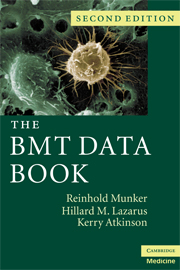Book contents
- Frontmatter
- Contents
- List of contributors
- Foreword
- Preface
- Acknowledgments
- Section 1 Basic science
- Section 2 Hematologic malignancies
- 2 Therapeutic decision making in BMT/SCT for acute myeloid leukemia
- 3 Therapeutic decision making in BMT/SCT for acute lymphoblastic leukemia
- 4 Therapeutic decision making in BMT/SCT for chronic myeloid leukemia and other myeloproliferative syndromes
- 5 Therapeutic decision making in BMT/SCT for chronic lymphatic leukemia
- 6 Therapeutic decision making in BMT/SCT for myelodysplasia
- 7 Therapeutic decision making in BMT/SCT for non-Hodgkin lymphoma
- 8 Therapeutic decision making in BMT/SCT for Hodgkin lymphoma
- 9 Therapeutic decision making in hematopoietic stem cell transplantation for multiple myeloma
- 10 Therapeutic decision making in BMT/SCT for amyloidosis
- Section 3 Solid tumors
- Section 4 Nonmalignant disorders
- Section 5 Practical aspects and procedures
- Section 6 Complications
- Section 7 The BMT/SCT pharmacopoeia
- Section 8 HLA-testing and laboratory medicine
- Appendix
- Index
- References
9 - Therapeutic decision making in hematopoietic stem cell transplantation for multiple myeloma
Published online by Cambridge University Press: 31 July 2009
- Frontmatter
- Contents
- List of contributors
- Foreword
- Preface
- Acknowledgments
- Section 1 Basic science
- Section 2 Hematologic malignancies
- 2 Therapeutic decision making in BMT/SCT for acute myeloid leukemia
- 3 Therapeutic decision making in BMT/SCT for acute lymphoblastic leukemia
- 4 Therapeutic decision making in BMT/SCT for chronic myeloid leukemia and other myeloproliferative syndromes
- 5 Therapeutic decision making in BMT/SCT for chronic lymphatic leukemia
- 6 Therapeutic decision making in BMT/SCT for myelodysplasia
- 7 Therapeutic decision making in BMT/SCT for non-Hodgkin lymphoma
- 8 Therapeutic decision making in BMT/SCT for Hodgkin lymphoma
- 9 Therapeutic decision making in hematopoietic stem cell transplantation for multiple myeloma
- 10 Therapeutic decision making in BMT/SCT for amyloidosis
- Section 3 Solid tumors
- Section 4 Nonmalignant disorders
- Section 5 Practical aspects and procedures
- Section 6 Complications
- Section 7 The BMT/SCT pharmacopoeia
- Section 8 HLA-testing and laboratory medicine
- Appendix
- Index
- References
- Type
- Chapter
- Information
- The BMT Data Book , pp. 139 - 156Publisher: Cambridge University PressPrint publication year: 2009



